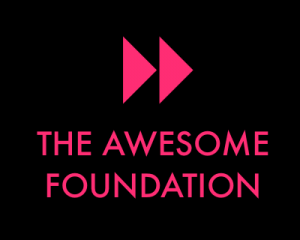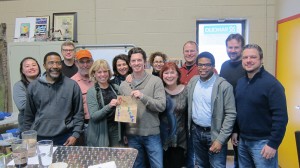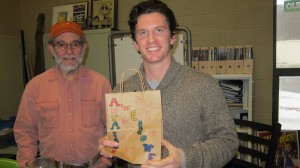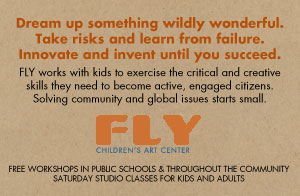 As I mentioned a while back, I’m one of a group of people to who decided, not too long ago, to start a local chapter of Boston’s Awesome Foundation. Well, this morning, our group – christened A2Awesome – handed over its first $1,000 grant.
As I mentioned a while back, I’m one of a group of people to who decided, not too long ago, to start a local chapter of Boston’s Awesome Foundation. Well, this morning, our group – christened A2Awesome – handed over its first $1,000 grant.
The funds were given, in a brown paper bag, to Nathan Ayers, of Ann Arbor, who will be using the money to construct two bike-powered vegetable grow racks, which will be used in the K-12 science classes he teaches in Ann Arbor and Detroit. According to Ayers, the intention is to create a closed loop system to demonstrate the principles of permaculture – a design and engineering philosophy based on ecology, which has as its objective the creation of sustainable food, energy and community infrastructure systems.
Ayers explains it as follows… “In this system, the human rides the bike, the bike produces energy, the energy powers the LED grow light, the grow light produces food, the human eats the food and has the energy needed to again ride the bike. Its a set of relationships that form a complete circle, which are all dependent on each other to function.”
Ayers hopes to use the funds to have the first bike built by April, so that he, and his students, can begin sprouting plants in early spring.
Here, for those who are interested in knowing more about Nathan’s project, is a brief interview that I conducted with him a few days ago.



MARK: Can you tell us a little about yourself?
NATHAN: Born and raised in Ann Arbor, I had a lot of great teachers, mentors and exposure to important things like music, art, film and critical thinking. As a kid, I played outside a lot and fell in love with nature. I did not have an affinity for science or math or anything like that growing up. I was in funk bands and played water polo in high school. I went to Indiana University and bounced around the roulette wheel of majors until I landed in Sociology, studying race and socio-economic systems. I got into activism through music while in college, and helped start the Hip Hop Congress. At IU, I also got real into self-sufficiency and alternative energy. This was around Y2K, and I think that maybe spooked me, but I was super fascinated with being able to live and thrive in nature. I started reading schematics for suitcase sized solar panel systems and portable power. After college, I traveled around, living in Australia and Sweden for a bit, and saw some really good examples of healthy and happy people and cultures. I eventually came back to Ann arbor around 2005 and began working for the Ann Arbor Public Schools. This was right when Michigan’s economy was really starting to tank (hey, at least we were first in something). My sociology degree didn’t mean much and I was originally hired as a lunch room supervisor. Within a couple months, a job opened up as a special needs paraprofessional and that’s what I did for about 4 years. I loved my time working in the schools, amazing people, kids and co-workers. During this time, I also went back to school and obtained certifications in solar photovoltaics and organic agriculture. I got a bit active around Ann Arbor’s green scene and helped start the now defunct Transition Ann Arbor. Through Transition Towns, I was introduced to Permaculture, – a design and engineering system based on the science of ecology. The philosophies and principles of a design school focused on integrating humanity’s food, energy and infrastructure with natural ecosystems and patterns was beyond inspiring. So much so that I quit my job and went out to California to take a permaculture design course. During my experience there, I was launched head and hands first into the world of agro-ecology, bio mimicry, appropriate technology and systems thinking, and that’s where my mind’s been ever since. I turned my house into a permaculture/makerspace R&D lab, and in 2011, began teaching permaculture at Washtenaw Community College. Last spring, we started a permaculture research and education company called Chiwara Permaculture, and have several problem based learning projects with K-12 schools and communities in Ann Arbor and Detroit.
MARK: What were the origins of this project? Had you been thinking about this for a while, or did the idea just come to you after hearing that, though A2Awesome, there was funding available for unique, impactful, or otherwise interesting, projects?
NATHAN: I have had the idea for this system for a while, utilizing the LED grow lights and the battery pack, but I’m definitely not the first person to think of amazing and useful things to do with a bicycle. I think we will eventually look back and see the bicycle as one of the most amazing machines humans ever invented. There is so much work that can be done with one, aside from transportation, like grinding grains, washing and drying clothes, pumping water and producing electricity. Permaculture design ultimately creates closed loop feedback mechanisms between systems, and that’s what I tried to do with this food production unit. The human rides the bike, the bike produces energy, the energy powers the grow light, the grow light produces food, the human eats the food, the human is sustained and can again ride the bike. Its a set of relationships that form a complete circle, which are all dependent on each other to function.
MARK: Now I’ve got a technical question. Do you think it’s possible, though a bike-powered generator such as the one you intend to build, to generate the lumens necessary to grow vegetables without natural light? I should add that I think it’s an awesome project regardless, as it will, at the very least, demonstrate to kids just how much power there actually is in sunlight.
NATHAN: I’ve got two answers: Yes and I think so. The ‘lumens necessary to grow vegetables’ are a function of the LED grow light. These LED systems were allegedly developed by NASA as they were researching ways to grow food for extended missions in space, like, to mars. The science they discovered was that many types of vegetative plants only need two wavelengths of color to develop: red and blue. Through the magic of R&D they started making super efficient, high lumen LED grow panels that were red and blue. There are huge indoor commercial growing operations in the Netherlands that are utilizing this technology, and I’ve even grown a few plants with some basic LED panels. So, yes, the indoor growing technology works. Now the “I think so”, and what I think you’re really asking, is whether or not this is a viable system to grow food at home? We know that the max wattage a human can put out on a given bicycle session is around 250 to 300watts. Utilizing 2 bikes, and 2 people pedaling an hour a day, with an interchangeable 2 battery system, our numbers are promising. Like you mentioned, there are a lot of lessons and fields of study embedded into this one design, so the multi-discipline educational prospects in a school setting are real inspiring.
MARK: Now that you have the money, what’s your next step? And just how long do you think that it will take before you have a working system that you and your students can put to use?
NATHAN: We will start acquiring the parts and pieces, assembling the motor and battery components, and then start testing how much wattage we can produce and store. We’ll begin testing different plant stocks for production and caloric numbers. I’m hoping we’ll have a working system with sprouts by April. I’m really excited to have the money to build a proper battery system. The bicycle generator is one of many hybrid systems I’ve thought of, that all power these portable, or what I call “compartmentalized” battery systems.. Funding this project will propel us to think about new and innovative ways to make and store energy at home. If you want a hint at some of the energy systems we’ve been thinking about, I’ve got one word: Drums.
MARK: Where might people see the unit in action once it’s up and running? You mentioned that you’ll likely be using with students in both Detroit and Ann Arbor, is that correct?
NATHAN: Yes, after we get the unit operating and producing, we will then be able to take it to our partner schools in Ann Arbor and Detroit so that students can design and build their own. There are so many areas for learning and research, and I can’t wait to see what kinds of ideas our students come up with. We also plan to post videos and the design schematics for the peddle powered vegetable grow rack on our website, open source style, so people can build and improve upon them. Hopefully it will someday make the rounds at various re-skilling festivals and community sustainability events.
MARK: As our first recipient, do you have any words of encouragement for others that might be thinking about applying.
NATHAN: Yes, DO IT! Get your ideas down on paper. Being able to translate an idea into a great proposal is an extremely valuable skill, something we should be teaching every student how to do. It’s really the art of effective communication. If there is one thing the world needs right now, it is for really good ideas to be effectively communicated and implemented. Thanks to the A2Awesome for helping a new generation of ideas get out there.
I should add that we had a lot of very good applications this first round. I know I complain a lot about stuff on this site, but we really are fortunate to be living in a community where we have so many bright, creative people working to solve the problems that face us. It’s truly inspiring, and I’m thankful that, due to some weird series of events, I’m in a position not only to interact with these people, but to maybe even help some of them, through A2Awesome, get their projects off the ground.
If you have an awesome idea, please consider applying for this month’s grant. All you have to do is click here and fill out the submission form to get the ball rolling.
BACKGROUND:
A2 Awesome is organized under the banner of the Boston-based Awesome Foundation. The stated purpose of the local group, according to our chairwoman, Lisa Dengiz, is “to have fun by providing streamlined seed funding for creative projects that will bring surprise, delight and joy to the community.” The organization intends to make one grant a month for the foreseeable future. All grants will be in the amount of $1,000.
Chapter trustees contribute their own personal funds toward the $1,000, no-strings-attached grant each month, to an awesome project that promises to make life better. In addition to me and Lisa, trustees include Dick Soble, Paul Saginaw, Jeff Meyers, Linh Song, Heather MacKenzie, Monique Deschaine, Hans Masing, Alice Liberson, Omari Rush, Tanya Luz and Larry Gant.
Created in 2009 in Boston, the Awesome Foundation now has chapters in over 20 cities across the globe. In addition to the new Ann Arbor / Ypsilanti chapter, there are Awesome Foundation outposts in both Detroit and Grad Rapids. Projects funded have included efforts in a wide range of areas including technology, arts and social good.
And please share this post with all of your brilliant, creative, and visionary friends in S.E. Michigan. We have money to give, and we’d love to know if there are ambitious, inspiring ideas out there where $1,000 could really make a difference.












7 Comments
I forgot to include it in the post, but, here, from the press release, are my comments on our selection of Nathan as our first recipient.
Congratulations to Nathan. I look forward to hearing how their research goes. Scientific investigation with kids is indeed awesome.
“We don’t know if it’s technically feasible to grow plants through pedal power,”
I think Nate gave a good answer to this, but I might extend it by suggesting that your next awardee be someone who teaches kids about entropy.
I think you’d burn more calories than you’d create in the way of lettuce and tomatoes, but it’s still a totally awesome project, and this is a very welcomed news story, especially today, when I’ve been reading about the Ann Arbor pediatrician with a predilection for child porn and all kinds of other bad stuff.
Kudos to everyone involved in this. A very impressive project in all ways! A2AWESOME!
I met Nathan at a Permaculture Summit and was impressed with his connectedness to the environment and people. I think you made a perfect choice in Nathan as the first recipient of your award. If you continue to award people of his caliber and empower them in their ideas, the world will change for the better.
Thank you for making awesomeness more of a reality on this earth!!! Love the grant project!
4 Trackbacks
[…] castleBy Mark | February 21, 2012I just received a note from Nathan Ayers, the guy who won the first $1,000 grant from A2Awesome. He wanted to let me know that, back in 1984, the television program PM Magazine ran a feature on […]
[…] in the local community, making possible everything from an elementary education project involving bike-powered lighting systems to be used for growing vegetables, to a drama program at the Women’s Huron Valley Correctional Facility based on the works of […]
[…] in the local community, making possible everything from an elementary education project involving bike-powered lighting systems to be used for growing vegetables, to a drama program at the Women’s Huron Valley Correctional Facility based on the works of […]
[…] funded. Here in Washtenaw County, for instance, we’ve helped a permaculture educator build a bike-powered grow light system that he uses to teach local kids about plant growth, the power of the sun, and any number of other […]